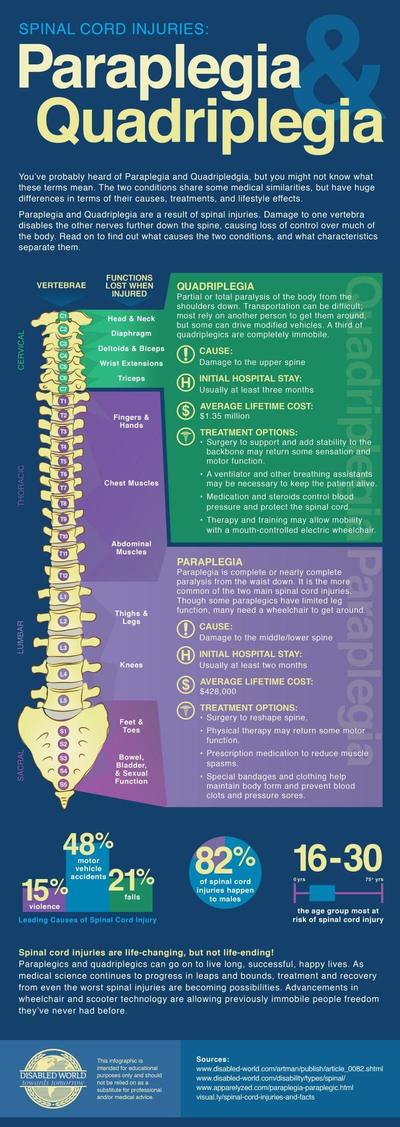Quadriplegia and Paraplegia Information and Infographic
Ian C. Langtree - Writer/Editor for Disabled World (DW)
Published: 2013/05/17 - Updated: 2024/05/02
Publication Type: Informative
Category Topic: Disability Information - Academic Publications
Page Content: Synopsis - Introduction - Main
Synopsis: Infographic contains information regarding the difference between Quadriplegia and Paraplegia including vertebra and spinal functions. Paraplegia is an impairment in motor or sensory function of the lower extremities. The extent of the paralysis depends on the level of the spinal cord at which the damage occurs. When both legs and arms are affected, the condition is called Quadriplegia.
Introduction
SCI Facts:
Main Content
Paraplegia - Paralysis from the waist down.
Quadriplegia - Paralysis from the shoulders down.
Complete Injuries - Result in the total loss of sensation and function below he injury level.
Incomplete Injuries - Result in partial loss of sensation and function below the injury level.
- There are 32 injuries per million population or 7800 injuries in the US yearly.
- An estimated additional 20 cases per million (4860 per year) die before reaching the hospital.
- 89.3% of all persons with spinal cord injury (SCI) who are discharged from the system are sent to private, non-institutional residence.
- 6.6% are discharged to nursing home.
- The rest are discharged to hospitals, group living situations and other destinations.
- Only 0.9% of Spinal Cord Injuries (SCI) fully recover.
- Average yearly expense for spinal cord injuries can range from $228,566 to $775,576 in the first year.
- Estimated lifetime costs due to spinal cord injury can range from $681,843 to over $3 million for a 25 year old.
- Only 52% of SCI individuals are covered by private health insurance at the time of injury.
(Continued below the infographic...)

Infographic provides information on paraplegia and quadriplegia including statistics.
(Continued...)
Causes of Paraplegia and Quadriplegia
- 48% motor vehicles
- 21% falls
- 15% violence
- 14% sports (66% which are diving related)
- 2% others
Race and Ethnicity
- 66% of those injured are Caucasian
- 26.2% are African American
- 2.1% are Asian
- 0.9% are Native American
Age and Gender Statistics
- 82% of those injured are male
- 18% are female
- Highest per capita rate of injuries occurs between the ages of 16-30
- Average age at injury is 33.4
- Median age at injury 26
- Mode age at injury 19
- Falls overtake leading cause after the age of 45
Marital Status at Injury
- 53% single
- 31% married
- 9% divorced
- 7% other
Employment Status
- 58.8% employed
- 41.2% unemployed (includes students, retirees and homemakers)
- After 8 years 34.4% of paraplegics and 24.3% of quadriplegics were still employed
 Author Credentials: Ian is the founder and Editor-in-Chief of Disabled World, a leading resource for news and information on disability issues. With a global perspective shaped by years of travel and lived experience, Ian is a committed proponent of the Social Model of Disability-a transformative framework developed by disabled activists in the 1970s that emphasizes dismantling societal barriers rather than focusing solely on individual impairments. His work reflects a deep commitment to disability rights, accessibility, and social inclusion. To learn more about Ian's background, expertise, and accomplishments, visit his full biography.
Author Credentials: Ian is the founder and Editor-in-Chief of Disabled World, a leading resource for news and information on disability issues. With a global perspective shaped by years of travel and lived experience, Ian is a committed proponent of the Social Model of Disability-a transformative framework developed by disabled activists in the 1970s that emphasizes dismantling societal barriers rather than focusing solely on individual impairments. His work reflects a deep commitment to disability rights, accessibility, and social inclusion. To learn more about Ian's background, expertise, and accomplishments, visit his full biography.